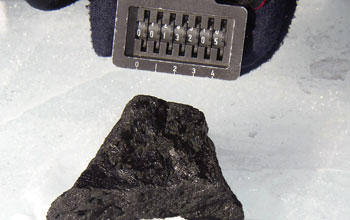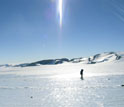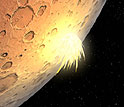News Release 04-094
New Martian Meteorite Found in Antarctica

The meteorite as it was collected in Antarctica.
July 20, 2004
This material is available primarily for archival purposes. Telephone numbers or other contact information may be out of date; please see current contact information at media contacts.
Broadcasters: Animation/B-Roll available on Betcam SP. Please contact Dena Headlee at dheadlee@nsf.gov, 703-292-7739.
ARLINGTON, Va.— While rovers and orbiting spacecraft scour Mars searching for clues to its past, researchers have uncovered another piece of the Red Planet in Antarctica.
The new specimen was found by a field party from the U.S. Antarctic Search for Meteorites program (ANSMET) on Dec. 15, 2003, on an icefield in the Miller Range of the Transantarctic Mountains, roughly 750 kilometers (466 miles) from the South Pole. This 715.2 gram (1.5 pound) black rock, officially designated MIL 03346, was one of 1358 meteorites collected by ANSMET during the 2003-2004 austral summer.
Scientists at the Smithsonian Institution's National Museum of Natural History involved in classification of Antarctic finds said the mineralogy and texture of the meteorite are unmistakably Martian. The new specimen is the seventh recognized member of a group of Martian meteorites called the nakhlites, named after the first known specimen that fell in Nakhla, Egypt in 1911.
Like the other Martian meteorites, MIL 03346 is a piece of the Red Planet that can be studied in detail in the laboratory, providing a critical "reality check" for use in interpreting the wealth of images and data being returned by the spacecraft currently exploring Mars. Following the existing protocols of the US Antarctic meteorite program, scientists from around the world will be invited to request samples of the new specimen for their own detailed research.
Thought to have originated within thick lava flows that crystallized on Mars approximately 1.3 billion years ago, and sent to Earth by a meteorite impact about 11 million years ago, the nakhlites are among the older known Martian meteorites. As a result they bear witness to significant segments of the volcanic and environmental history of Mars.
The US Antarctic Meteorite program is a cooperative effort jointly supported by NSF, NASA and the Smithsonian Institution. Antarctic field work is supported by grants from NASA and NSF to Case Western Reserve University; initial examination and curation of recovered Antarctic meteorites is supported by NASA at the Astromaterials Curation facilities at the Johnson Space Center in Houston, Texas; and initial characterization and long term curation of Antarctic meteorite samples is supported by NASA and the Smithsonian Institution at the National Museum of Natural History in Washington, D.C.
Details of the initial characterization of the specimen and sample availability are available through a special edition of the Antarctic Meteorite Newsletter, to be immediately released on the Web and mailed to researchers worldwide.
-NSF-
-
Meteorite MIL 03346 in the meteorite processing laboratory at the Johnson Space Center.
Credit and Larger Version -
A member of the 2003-2004 ANSMET team searches the Miller Range icefield in the Transantarctic ...
Credit and Larger Version -
View Video
This NSF animation shows how material from the surface of Mars can travel to Earth and become a ...
Credit and Larger Version -
View Video
Download broadcast quality version of the NSF animation.
Credit and Larger Version
Media Contacts
Leslie Fink, NSF, (703) 292-5395, email: lfink@nsf.gov
Donald Savage, NASA, (202) 358-1727, email: Donald.L.Savage@nasa.gov
Jeffrey Bendix, Case Western, (216) 368-6070, email: Jeffrey.Bendix@case.edu
Paul Taylor, Smithsonian, (202) 357-2627, email: taylorp@PublicAffairs.SI.EDU
Program Contacts
Timothy McCoy, Smithsonian Institution, (202) 633-2206, email: mccoy.tim@nmnh.si.edu
Kevin Righter, Astromaterials Curation at NASA’s Johnson Space Center, (281) 483-5125, email: kevin.righter-1@nasa.gov
Related Websites
The Case Western University ANSMET page: http://geology.cwru.edu/~ansmet/
NASA's Mars Meteorite Compendium: http://curator.jsc.nasa.gov/curator/antmet/mmc/mmc.htm
An NSF fact sheet on the Antarctic Search for Meteorites (ANSMET) Program: http://www.nsf.gov/od/lpa/news/media/01/fsmeteorites.htm
An NSF news release about grants to study meteorite ALH84001, which some scientists believe contains evidence that microscopic life once existed on Mars: http://www.nsf.gov/od/lpa/news/press/pr9750.htm
More information about nakhlites and other Martian meteorites can be found at NASA Johnson Space Center's Astromaterials Curation website.: http://curator.jsc.nasa.gov/curator/antmet/marsmets/contents.htm
A news release about research by NSF-supported scientists indicating that dust-covered glaciers in Antarctica's McMurdo Dry Valleys may lock up water just below the valley surface: http://www.nsf.gov/od/lpa/news/03/pr03149.htm
The U.S. National Science Foundation propels the nation forward by advancing fundamental research in all fields of science and engineering. NSF supports research and people by providing facilities, instruments and funding to support their ingenuity and sustain the U.S. as a global leader in research and innovation. With a fiscal year 2023 budget of $9.5 billion, NSF funds reach all 50 states through grants to nearly 2,000 colleges, universities and institutions. Each year, NSF receives more than 40,000 competitive proposals and makes about 11,000 new awards. Those awards include support for cooperative research with industry, Arctic and Antarctic research and operations, and U.S. participation in international scientific efforts.
Connect with us online
NSF website: nsf.gov
NSF News: nsf.gov/news
For News Media: nsf.gov/news/newsroom
Statistics: nsf.gov/statistics/
Awards database: nsf.gov/awardsearch/
Follow us on social
Twitter: twitter.com/NSF
Facebook: facebook.com/US.NSF
Instagram: instagram.com/nsfgov






